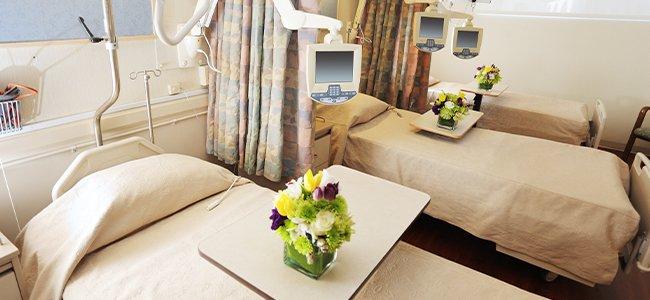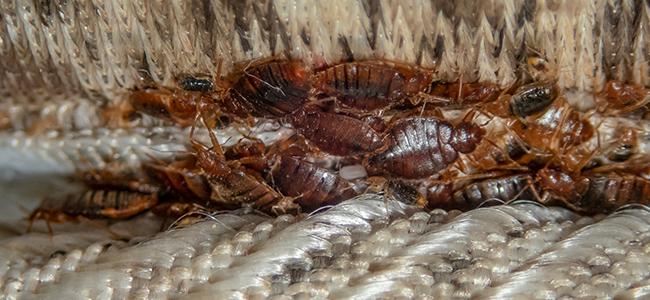
Fact vs. Myths: Bed Bugs In Washington D.C.
01/20/2022
Bed bugs are small parasitic pests that often resemble an apple seed to the naked eye. They have a wingless, oval-shaped body with a reddish-brown ...
READ MORE >
03/31/2020

As a healthcare professional, you take your job to protect the health of your patients very seriously. Whether you work directly with patients or oversee a facility, you know that maintaining sanitary standards and keeping abreast of the latest developments in the field is important in keeping things running smoothly.
A bed bug infestation may not be on your radar, but it should be! Bed bugs have become an increasingly large problem over the past couple of decades with infestations able to occur wherever people are present. American Pest has created this professional’s guide to bed bugs in Columbia’s healthcare facilities to help you get the information you need.
Bed bugs are insects that get their name due to their propensity to feed on humans at night while they’re sleeping in bed. However, as we’ll discuss later, beds are not the only place where bed bugs are found.
Adult bed bugs have two appearances, depending on if they are unfed or have just eaten. An unfed bed bug is brown with a wide, flat, oval-shaped body. A bed bug that has just eaten is reddish-brown with an engorged body. Adult bed bugs are about the size of an apple seed with six legs, a small head, and two antennae that stick out straight to each side of their head.
Adult bed bugs feed on blood. Although typically nocturnal, they will come out during the day to feed if necessary. It takes about five to ten minutes for a bed bug to complete a meal. After it finishes eating, the bed bug will go to a secluded place to digest its meal, mate, and, if female, lay eggs.
Bed bug nymphs have the same shape as adult bed bugs but are smaller, translucent, and whitish in color if they haven’t recently eaten. Like adult bed bugs, bed bug nymphs also feed on blood. They easily blend into their surroundings due to their size and lack of color. Nymphs go through five molts before becoming adult bed bugs, darkening in color with each molt. It takes approximately three weeks for a nymph to grow to an adult.
Bed bug eggs are tiny and white. They’re usually laid in out-of-the-way locations, such as in the cracks of floors or along the seams of mattresses or other upholstered furniture. Eggs typically hatch within one to two weeks of being laid.
When an infestation of any pest is a possibility, one of the first things you want to know is if that pest is dangerous. When it comes to bed bugs, the answer is a little complicated.
The good news is that bed bugs are not known to spread disease. They also won’t eat away at your walls or cause significant damage to your building. However, there is bad news too.
Bed bugs bite. Although their bites may not cause any serious illnesses, they are still itchy and irritating. In some cases, people can have an allergic reaction to a bed bug bite. While these are usually mild, in very rare cases an anaphylactic reaction could occur. Furthermore, if you scratch at an itchy bed bug bite, you could develop a secondary infection. When you’re dealing with patients who may already have compromised immune systems, you don’t want to take any chances or put them at further risk.
Although bed bugs won’t damage your building in any kind of structural way, they can damage other things. Droplets of blood can often be found on sheets or other linens after they’ve had a meal, they leave streaks of urine and fecal matter on the things they walk across, and they’ll leave discarded skins and eggs in the areas where they spend most of their time.
Bed bugs will also severely damage your healthcare facility’s reputation. If your facility ends up with an infestation and word gets out about it, the news will quickly spread and people will think twice before choosing to give you business.
Most pest infestations occur when pests are around the exterior of your property and find a way inside your building. Because of how they get inside, it’s easy to provide consistent exterior treatments to keep them out. Unfortunately, bed bugs do not operate in the same way as most other pests.
Bed bugs are the jet setters of the insect world. They love to travel and they’re really good at it too. The way that the vast majority of bed bug infestations begin is when a bed bug crawls onto a person or into a bag and is carried to a new location.
Most of the time a person is not going to notice if a tiny bug has crawled onto their shoe or clothing. They’re even less likely to see a bed bug hidden inside a backpack, purse, grocery bag, or piece of luggage. Because of that, people easily and frequently become the unwitting taxi service for bed bugs everywhere. At some point, as they go from place to place, the bed bug will crawl off their free ride, ready to settle down in their new location.
When you gain an understanding of how bed bugs travel from place to place, it becomes easy to understand that although any location, public or private, is susceptible to a bed bug infestation, certain places are at an even greater risk.
A person living alone in a single-family home who never has visitors may end up with a bed bug infestation, but the only way that could happen is if that person brings the bed bugs into the house himself. While still very possible, the chances of this person’s home ending up with a bed bug infestation are relatively low.
On the other hand, Columbia’s healthcare facilities, including physician’s offices, hospitals, nursing homes, and more, see an incredible amount of foot traffic every single day. Hundreds, and even thousands, of people come in and out of these facilities daily. If even one of the people who walk through the doors is carrying a bed bug on them, that bed bug could end up staying in the building.
Although one bed bug might not seem like much of a threat, bed bug infestations can grow at a rapid rate. Adult female bed bugs typically lay between one and seven eggs a day, laying up to 500 in a lifetime. These eggs take about a week to hatch and three weeks to mature. Once adults, the newly mature females will also begin to reproduce. While slow at first, especially compared to many other pests, once an infestation gets going, it grows at an exponential rate.
Even if your facility does not have beds, bed bugs will still feel right at home. Bed bugs don’t only live on mattresses, but also on furniture, behind picture frames, in the cracks and crevices of flooring and walls, and even inside electrical outlets. If there is a place to hide, bed bugs will find it and be quite comfortable.
Bed bugs are one of the most difficult pests to prevent because of how they move from place to place. If you were simply concerned about your home becoming infested, you could carefully check over yourself, your family members, and the items you brought inside to ensure that they were bed bug-free.
In the case of a healthcare facility however, it’s not as easy. You can’t inspect every patient or visitor who walks through your doors, so there’s no reliable way of preventing bed bugs from getting inside your office, hospital, or nursing home.
Even so, there are a few things you can do to reduce the risk of getting bed bugs in your Columbia healthcare facility:
Eliminate as much clutter as possible to reduce the areas where bed bugs can hide.
Eliminate as much upholstered furniture as possible.
Encase all mattresses in protective covers.
Vacuum frequently.
Put outlet covers in electrical sockets to make it more difficult for bed bugs to get into the walls.
Install door sweeps and seal all cracks and crevices to discourage bed bug movement from one room to another.
Wash and dry all laundry on a hot cycle.
Do frequent inspections to look for any signs of bed bugs.
Although none of the suggestions above will stop bed bugs from getting into your healthcare facility, they will make it more difficult for an infestation to grow. Of all of the suggestions, performing frequent inspections to look for any signs of a bed bug infestation is the most important. Early detection is a key component in eliminating bed bugs in as simple and timely a manner as possible.
If you see any signs of bed bugs, contact American Pest immediately. As a commercial bed bug client, you will be paired with a team liaison to walk you through the entire bed bug control process. We’ll begin by listening to your concerns and consulting with you about the unique needs of your healthcare facility. Our bed bug expert will review the layout of your building, your key areas of concern, your treatment objectives, and your budget, amongst other things. With this information in mind, we’ll develop a treatment plan that works for your facility and provide you with a quote for our services.
Your treatment plan will be fully customized to your healthcare facility’s needs and may include any of the following methods:
Visual inspections
K-9 inspections
Bed bug monitoring devices
Conventional bed bug treatments
Thermal (heat) bed bug treatments
With American Pest, you’ll receive a thorough, systematic approach to bed bug control with guaranteed results. Bed bugs don’t have to be a problem for your healthcare facility. Contact American Pest to schedule a meeting with your bed bug liaison.

01/20/2022
Bed bugs are small parasitic pests that often resemble an apple seed to the naked eye. They have a wingless, oval-shaped body with a reddish-brown ...
READ MORE >

12/10/2021
It takes a lot to open and maintain a business. Pests can take your entrepreneurial dreams away. It’s best to stay ahead of them by learning ...
READ MORE >

12/03/2021
Bed bugs can be difficult to identify, but this guide is here to help you tell them apart from other pests in Washington D.C. Read on to get the ma...
READ MORE >

11/15/2021
Bed bugs may be small, but they can often cause major problems once they infest your Maryland home. Contact the professionals a...
READ MORE >

Protect your home and family from nuisance and potentially damaging pests with a Preferred Care home pest control plan. Starting at $49/month

Don't let the bed bugs bite a second longer. Contact American Pest for the most comprehensive bed bug control in the industry. Learn More

Our certified rodent control pros will put an end to your frustration by getting rid of rats and mice inside your home. Learn More

Say goodbye to wood-destroying termites in your home when you contact American Pest for expert termite control. Learn More

Trust American Pest to deliver professional backyard tick control services that are guaranteed to get results. Learn More

Don't spend the warm-weather season indoors, find out how American Pest's professional treatments get rid of mosquitoes. Learn More
Fill out the form and recieve feedback in less than 5 minutes. For immediate service please call.